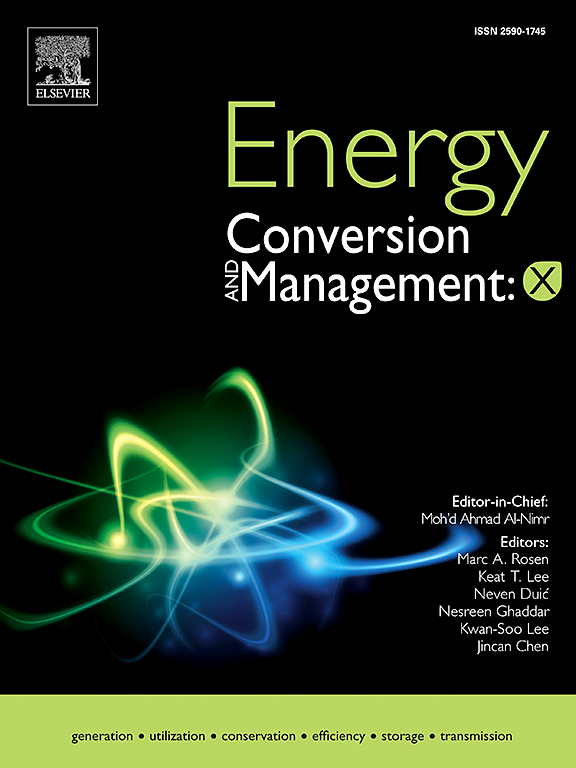插电式混合动力汽车不同工况下能量流及二氧化碳排放实验分析
IF 10.9
1区 工程技术
Q1 ENERGY & FUELS
引用次数: 0
摘要
插电式混合动力汽车正在成为传统内燃机汽车的可行替代品,在交通运输领域显示出降低能源消耗和抑制污染物排放的巨大潜力。本研究利用实验室底盘测功机,研究了插电式混合动力汽车在耗电模式和保电模式下的能量流、能耗和二氧化碳排放特性。研究结果表明,在耗尽电量模式下,高压电池电压范围为320 ~ 370 V,电流范围为−116.9 ~ 147.4 A。在制动过程中,电机将机械能转化为电能,为高压电池充电,从而实现能量回收。此外,在充电保持模式下,发动机在运行过程中对高压电池充电;然而,来自发电机的充电电流相对较低,约为- 58 A。能耗分析表明,插电式混合动力汽车在耗尽电模式下的能耗比保持电模式下的能耗低68.3%以上。反之,当用电量转换为标准煤消耗时,耗电模式下的二氧化碳排放因子(145.40 g/km)比充电模式下的二氧化碳排放因子高9.5%以上。因此,插电式混合动力汽车在提高能源效率和减少对石油的依赖方面具有明显的优势,是促进交通运输部门脱碳的重要途径。本文章由计算机程序翻译,如有差异,请以英文原文为准。
Experimental analysis of energy flow and carbon dioxide emissions in plug-in hybrid electric vehicles under different operation modes
Plug-in hybrid electric vehicles are emerging as a viable alternative to conventional internal combustion engine vehicles, demonstrating significant potential for reducing energy consumption and curbing pollutant emissions within the transportation sector. This study used a chassis dynamometer in a laboratory to investigate the energy flow, energy consumption, and carbon dioxide emission characteristics of plug-in hybrid electric vehicles under both charge-depleting and charge-sustaining modes. The research findings indicate that in charge-depleting mode, the high-voltage battery voltage ranges from 320 to 370 V, with current varying between −116.9 and 147.4 A. During the braking process, energy recovery occurs as the electric motor converts mechanical energy into electrical energy to recharge the high-voltage battery. Furthermore, in charge-sustaining mode, the engine charges the high-voltage battery during operation; however, the charging current from the generator is relatively low, reaching approximately −58 A. An analysis of energy consumption revealed that the energy consumption of plug-in hybrid electric vehicles in charge-depleting mode is over 68.3 % lower than that in charge-sustaining mode. Conversely, when electricity consumption is converted to standard coal consumption, the carbon dioxide emission factor in charge-depleting mode (145.40 g/km) is more than 9.5 % higher than in charge-sustaining mode. Therefore, plug-in hybrid electric vehicles exhibit clear advantages in improving energy efficiency and reducing dependence on oil, representing a significant approach to promoting decarbonization in the transportation sector.
求助全文
通过发布文献求助,成功后即可免费获取论文全文。
去求助
来源期刊

Energy Conversion and Management
工程技术-力学
CiteScore
19.00
自引率
11.50%
发文量
1304
审稿时长
17 days
期刊介绍:
The journal Energy Conversion and Management provides a forum for publishing original contributions and comprehensive technical review articles of interdisciplinary and original research on all important energy topics.
The topics considered include energy generation, utilization, conversion, storage, transmission, conservation, management and sustainability. These topics typically involve various types of energy such as mechanical, thermal, nuclear, chemical, electromagnetic, magnetic and electric. These energy types cover all known energy resources, including renewable resources (e.g., solar, bio, hydro, wind, geothermal and ocean energy), fossil fuels and nuclear resources.
 求助内容:
求助内容: 应助结果提醒方式:
应助结果提醒方式:


